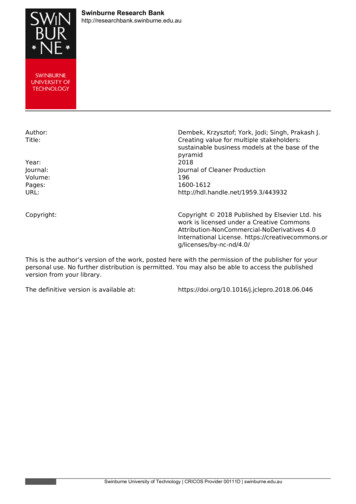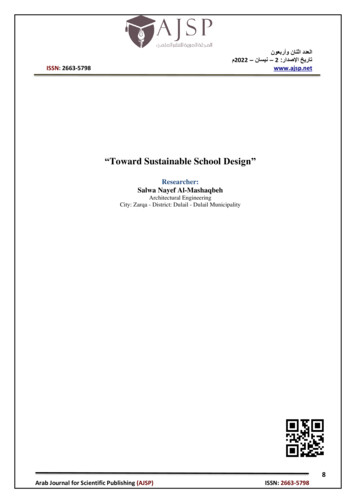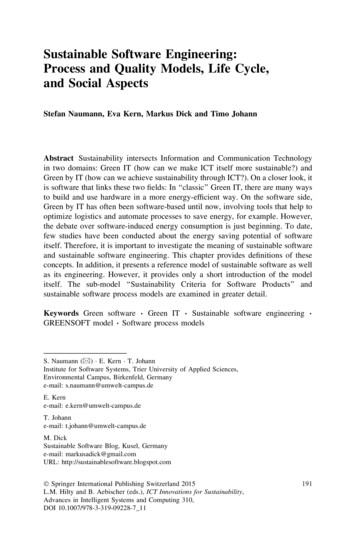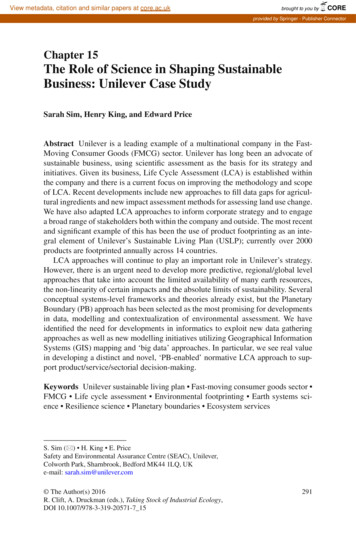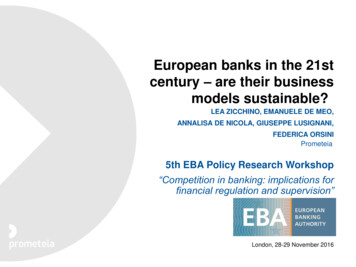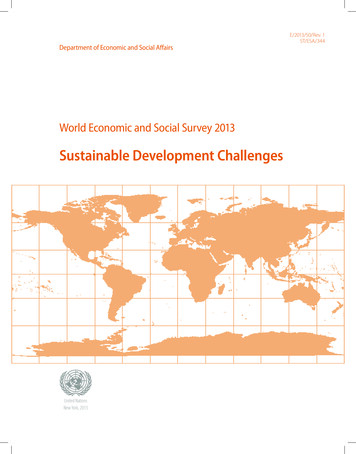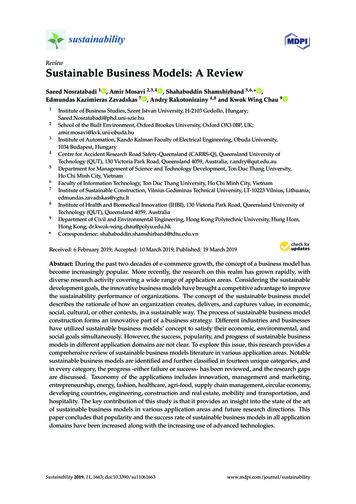
Transcription
sustainabilityReviewSustainable Business Models: A ReviewSaeed Nosratabadi 1 , Amir Mosavi 2,3,4 , Shahaboddin Shamshirband 5,6, * ,Edmundas Kazimieras Zavadskas 7 , Andry Rakotonirainy 4,8 and Kwok Wing Chau 9123456789*Institute of Business Studies, Szent Istvan University, H-2103 Godollo, Hungary;Saeed.Nosratabadi@phd.uni-szie.huSchool of the Built Environment, Oxford Brookes University, Oxford OX3 0BP, UK;amir.mosavi@kvk.uni-obuda.huInstitute of Automation, Kando Kalman Faculty of Electrical Engineering, Obuda University,1034 Budapest, HungaryCentre for Accident Research Road Safety-Queensland (CARRS-Q), Queensland University ofTechnology (QUT), 130 Victoria Park Road, Queensland 4059, Australia; r.andry@qut.edu.auDepartment for Management of Science and Technology Development, Ton Duc Thang University,Ho Chi Minh City, VietnamFaculty of Information Technology, Ton Duc Thang University, Ho Chi Minh City, VietnamInstitute of Sustainable Construction, Vilnius Gediminas Technical University, LT-10223 Vilnius, Lithuania;edmundas.zavadskas@vgtu.ltInstitute of Health and Biomedical Innovation (IHBI), 130 Victoria Park Road, Queensland University ofTechnology (QUT), Queensland 4059, AustraliaDepartment of Civil and Environmental Engineering, Hong Kong Polytechnic University, Hung Hom,Hong Kong; dr.kwok-wing.chau@polyu.edu.hkCorrespondence: shahaboddin.shamshirband@tdtu.edu.vnReceived: 6 February 2019; Accepted: 10 March 2019; Published: 19 March 2019 Abstract: During the past two decades of e-commerce growth, the concept of a business model hasbecome increasingly popular. More recently, the research on this realm has grown rapidly, withdiverse research activity covering a wide range of application areas. Considering the sustainabledevelopment goals, the innovative business models have brought a competitive advantage to improvethe sustainability performance of organizations. The concept of the sustainable business modeldescribes the rationale of how an organization creates, delivers, and captures value, in economic,social, cultural, or other contexts, in a sustainable way. The process of sustainable business modelconstruction forms an innovative part of a business strategy. Different industries and businesseshave utilized sustainable business models’ concept to satisfy their economic, environmental, andsocial goals simultaneously. However, the success, popularity, and progress of sustainable businessmodels in different application domains are not clear. To explore this issue, this research provides acomprehensive review of sustainable business models literature in various application areas. Notablesustainable business models are identified and further classified in fourteen unique categories, andin every category, the progress -either failure or success- has been reviewed, and the research gapsare discussed. Taxonomy of the applications includes innovation, management and marketing,entrepreneurship, energy, fashion, healthcare, agri-food, supply chain management, circular economy,developing countries, engineering, construction and real estate, mobility and transportation, andhospitality. The key contribution of this study is that it provides an insight into the state of the artof sustainable business models in various application areas and future research directions. Thispaper concludes that popularity and the success rate of sustainable business models in all applicationdomains have been increased along with the increasing use of advanced technologies.Sustainability 2019, 11, 1663; ability
Sustainability 2019, 11, 16632 of 30Keywords: sustainable business model; sustainable development; sustainability; business model;review; survey; state-of-the-art; climate change; climate protection; global warming; research method;circular economy; sustainable mobility; mitigation; adaptation1. IntroductionThe business model concept is an abstract representation of the value flow and the interactionsbetween value elements of an organizational unit. The essential value elements of organizationsare concerned with proposition, creation, delivering, and capturing value. A simplified wayof communicating the connection and function of these elements is vital in the success of anybusiness [1]. For this purpose, the concept of a business model originated to facilitate theexplanation of complex business ideas more efficiently. Through a business model, the businessworkflow is communicated to investors in detail within a short time frame [2]. In fact, the effectiverepresentation of planning, analysis, communication, and implementation of organizational complexunits’ performance are reported as one of the major reasons behind the popularity of businessmodels [3]. Geissdoerfer et al. [4] present a detailed review of the different types and variousdefinitions of business models, where a vast number of definitions are presented. The model ofan organizational system [5], a simplified characteristic of the business concept [6], and a reducedscope of business [7] are suggested as the various types of business models. For decades, vitalsustainability issues with their major societal and environmental effects influencing human beings andnature had not been the priorities of most business model types. Nevertheless, business models, forachieving the sustainability goals of companies, have finally become under pressure to transform intoa more sustainable economic system.Internationalization, along with the urge to keep up with sustainable development goals, has madethe worldwide competition among firms more complex, with conventional business models strugglingto find appropriate solutions. In this context, the alternative concept of the sustainable business modelhas brought a competitive advantage to organizations through empowering the conventional businessmodels to meet the sustainable development goals while maintaining productivity and profitability [8].Thus, creating value for the triple bottom line, i.e., economic, society, and the environment, has been theultimate goal of sustainable business models [9]. Sustainable business models have great potential toincorporate the principles of sustainability and integrate sustainability goals into the value proposition,value creation, and value capture activities of businesses [10]. Sustainable business models aim atemploying proactive multi-stakeholder management, innovation, and a long-term perspective to meetsustainability goals. Sustainable business models, therefore, have been effectively contributing toreducing the harmful effects of business activities on the environment and society through providingsolutions to help firms meet their economic and sustainability goals simultaneously [11]. Thus,the concept of the sustainable business model has emerged to provide a platform for integratingsustainability considerations. From this perspective, circular business models are similar to sustainablebusiness models. However, they include additional characteristics, which are mainly concerned withslowing, intensifying, and narrowing resource loops [4].The review paper of Evans et al. [12] shows how sustainable business models have helpedbusinesses to achieve their sustainability ambitions. Further research, e.g., Boons et al. [10],Geissdoerfer et al. [4], and Schaltegger et al. [8], provides a collection of the definitions to theconcept of sustainable business model. According to Lüdeke-Freund [13], sustainable business modelsare tools for delivering social and environmental sustainability to industrial systems. However,there are constraints for understanding the sustainable business models and the available innovativealternatives for transformation to sustainability [14]. Despite much research on sustainable businessmodels in the literature, there is no comprehensive picture of how firms in different industries canimplement sustainability in their business models. Although there exists literature on the definitions
Sustainability 2019, 11, 16633 of 30and overview of the concept of the sustainable business model, there is a research gap in the progressand evaluation of the performance of sustainable business models in each specific application domain.The spread and effectiveness of sustainable business models in business domains have not beenidentified. Furthermore, the applicability, popularity, success, and future trends in various businessdomains have not yet been discussed. Consequently, the contribution of this article is the presentationof a classification of the widespread applications of sustainable business models, in addition to anin-depth investigation of various application domains considering the success and failure cases.The rest of this paper is structured as follows. Section two presents the methodology of the review.Section three presents the taxonomy of the research and the review’s initial report. Further, in thefourteen subsections, the applications of sustainable business models in the individual categories arepresented. Section four and five respectively present the discussion and conclusions of the research.2. MethodologyThe primary goal of this literature survey is to present the state of the art of sustainable businessmodels in the individual application areas. Accordingly, the research methodology has been developedto identify, classify, and review the notable peer-reviewed articles in the design and implementation ofsustainable business models in top-level subject fields. Using the Thomson Reuters Web-of-Science(WoS) and Elsevier Scopus for implementation of the search queries assures that any paper in thedatabase would meet four criteria of the quality measure, i.e., source normalized impact per paper(SNIP), CiteScore, SCImago journal rank (SJR), and h-index. Through the search query of “businessmodel*” and “sustainab*” for the title, abstract, and keywords, the relevant literature is identified. Thequery of (TITLE-ABS-KEY ("business model*”) AND TITLE-ABS-KEY (sustainab*)) would result in6,330 document results (3,494 document in the Scopus and 2,836 documents in WoS). However, throughauxiliary search keywords such as "sustainable development" in all fields of the paper, we make surethat the most relevant papers are identified, and that the paper significantly contributes to the definitionof sustainable development. Consequently, the alternative search query of (TITLE-ABS-KEY (“businessmodel*") AND TITLE-ABS-KEY (sustainab*) AND ALL ("sustainable development")) would resultin 1,584 document results (875 results in the Scopus and 709 results in the WoS), which would formour initial database. Reading in detail the articles’ relevancy decreased the numbers to 66 articles forfinal consideration. The research methodology follows a comprehensive and structured workflowbased on a systematic database search and cross-reference snowballing. The flowchart of the researchmethodology is presented in Figure 1. The method is considered as a modified version of the reviewproposed by [15].In the first step, the search queries explore the Thomson Reuters Web-of-Science and ElsevierScopus databases. In the second step, the abstract and keywords of the identified articles are browsedto identify the relevant literature and exclude the irrelevant ones. In step three, the database of therelevant articles is created. In step four, the article is carefully read, and the category of the applicationis identified accordingly. In this step, the expert-based knowledge and the initial preferences influencethe number and the type of categories. In step five, we decide on generating a new category and exportthe article in a new table of application domain or pass the article to step six, where a category hostsan article in its table. Once a category is created for a new article, in step seven, we pass that articleto that category. In step eight, we save the content of our database in various categories, update thecontent of the tables, and review the papers. This workflow is repeated until sorting out all the papers.
Sustainability 2018, 10, x FOR PEER REVIEW4 of 31Sustainability 2019, 11, 1663Search Queries4 of 30Step. 1Browsing the abstracts and keywords: considering the relevanceExcludedStep. 2Add to the database for the detailed considerationReading the papers to find the categoriesStep. 5Step. 3Step. 4Make a newAdd to the existing categories if the Step. 6categorycontent is originalStep. 8Step. 7Add to theDevelop the tables, review, and repeatcategoryuntil all the papers are categorized1. Flowchartthe methodologyof research.FigureFigure1. Flowchartof the ofmethodologyof research.3. Review3. ReviewStudyingthe As it isAsdepictedin FigureStudyingthe it is depictedin 2,Figurethe numberof publicationsin a sustainablebusiness businessmodel remarkablyincreasedincreasedduring theduringpast two2, the numberof publicationsin a sustainablemodel remarkablythe pastdecades.twoOnlydocumentswere publishedin this areain area2002inin2002comparisonto 62 documentstwo Onlydecades.two documentswere publishedin thisin comparisonto 62 documentsin 2016documentsin 2017.This Thisimpliesthat onetheofmajorsolutionsfor sustainablein and2016 74and74 documentsin 2017.impliesthat ofonethe majorsolutionsfor elopment is a sustainable business model and the firms have utilized sustainable businessmodelsSustainability 2018, 10, x FOR PEER REVIEW5 of 31to performeco-sociofriendlybusinessactivities.to more, the nature of a particular business is very determinant in the approaches that thefirms can select for their sustainable business models. In fact, the solutions provided in the literaturepresent different characteristics for the implementation of sustainable business models according tothe business domain. On the other hand, the implementation of a sustainable business model impliesnew challenges, innovation, or adjustment with new activities. Since sustainability deals with triplebottom line factors, in addition to the financial benefit [14,16,17], the benefits of multiplestakeholders, such as customers, suppliers, shareholders, etc., have been considered in sustainabledevelopment. Therefore, the transition toward sustainable business models requires people to lookbeyond the entity of the firm and it needs innovation activities to create value for the triple bottomline. Hence, incremental changes are insufficient to address sustainable development challenges [18,19]. The current study provides insights into the research path of the sustainable business model. Thepaper, as a literature review, increases the knowledge of how different industries, sectors, andresearch areas apply sustainable business models in order to achieve sustainability goals andprogresstowards sustainable development.Figure 2. The number of publications on sustainable business models from 1999-2018.Figure 2. The number of publications on sustainable business models from 1999-2018.Furthermore, the nature of a particular business is very determinant in the approaches that thedatabaseof the literaturedisclosedthe numberof publicationsfirmsThecan initialselect fortheir sustainablebusinessmodels.thatIn fact,the solutionsprovided seenthat thepresent different characteristics for the implementation of sustainable business models ),JournalofCleanerProduction(with49documents),the business domain. On the other hand, the implementation of a sustainable business model impliesProcediaCIRP innovation,(with 25 documents),WaterManagement(with 15 documents),andnewchallenges,or adjustmentwithResourcesnew activities.Since sustainabilitydeals with 24documents)arethemajorjournalsthathavebottom line factors, in addition to the financial benefit [14,16,17], the benefits of multiple-stakeholders,published the results and findings of research on sustainable business models. Figure 3 also clarifiesthat the number of documents published in these journals has been increasing, particularly from 2014onward. The journals of Cleaner Production and Sustainability have had the most share of this trendas they have published the most publications on sustainable business models.
Sustainability 2019, 11, 16635 of 30such as customers, suppliers, shareholders, etc., have been considered in sustainable development.Therefore, the transition toward sustainable business models requires people to look beyond theentity of the firm and it needs innovation activities to create value for the triple bottom line. Hence,incremental changes are insufficient to address sustainable development challenges [18,19]. Thecurrent study provides insights into the research path of the sustainable business model. The paper, asa literature review, increases the knowledge of how different industries, sectors, and research areasFigure 2. The number of publications on sustainable business models from 1999-2018.apply sustainable business models in order to achieve sustainability goals and progress towardssustainable development.The initial database of the literature disclosed that the number of publications on sustainableThe initial database of the literature disclosed that the number of publications on sustainablebusiness models, as it is also shown in Figure 3, has been increasing year by year. It is seen that thebusiness models, as it is also shown in Figure 3, has been increasing year by year. It is seenjournal of Sustainability (with 44 documents), Journal of Cleaner Production (with 49 documents),that the journal of Sustainability (with 44 documents), Journal of Cleaner Production (with 49ProcediaCIRP (with 25 documents), Water Resources Management (with 15 documents), anddocuments), Procedia CIRP (with 25 documents), Water Resources Management (with 15 documents),EnvironmentDevelopment and Sustainability (with 24 documents) are the major journals that haveandEnvironmentDevelopmentSustainability(with 24 documents)are themajorjournalsthatpublished the resultsand findingsandof researchon sustainablebusiness models.Figure3 alsoclarifieshavethepublishedtheresults andfindingsinoftheseresearchon sustainablebusiness particularlymodels. Figurealsothatnumber ofdocumentspublishedjournalshas been cularlyonward. The journals of Cleaner Production and Sustainability have had the most share of this trendfrom2014onward.Thethejournalsof Cleaner Productionand Sustainabilityhave had the most share ofastheyhavepublishedmost publicationson sustainablebusiness models.this trend as they have published the most publications on sustainable business models.Figure 3. The number of publications on the sustainability business model in different journals.Thethenumberpublicationsthe sustainabilitybusinessmodelin differentjournals.businessInFigureFigure3. 4,data ofrelatedto theondifferentsubject areashaveutilizedsustainablemodels in either their title, abstract, or keywords. The pie chart on the left side refers to the documentsIn Figure 4, the data related to the different subject areas have utilized sustainable businesspublished from 2007 to 2018, and the right-side pie chart refers to the documents published from 2015models in either their title, abstract, or keywords. The pie chart on the left side refers to the documentsonward. According to Figure 3, ‘Business, Management and Accounting (with 17.4%)’, ‘Engineeringpublished from 2007 to 2018, and the right-side pie chart refers to the documents published from 2015(with 13.5%)’, ‘Environmental Science (with 12.7%)’, and ‘Social Science (with 11.2%)’ are respectivelyonward. According to Figure 3, ‘Business, Management and Accounting (with 17.4%)’, ‘Engineeringthe subject areas that have borrowed the concept of sustainable business models and all together, they(with 13.5%)’, ‘Environmental Science (with 12.7%)’, and ‘Social Science (with 11.2%)’ are respectivelyhave published more than half (i.e., 54.8%) of the documents. During the last three years, from 2016,the subject areas that have borrowed the concept of sustainable business models and all together,the focus of the order of subject areas has changed and ‘Environmental Science (with 18.6%)’, ‘Business,they have published more than half (i.e., 54.8%) of the documents. During the last three years, fromManagement, and Accounting (with 16.4%)’, ‘Social Science (with 14.4%)’, and ‘Engineering (with2016, the focus of the order of subject areas has changed and ‘Environmental Science (with 18.6%)’,12.3%)’ are subject areas that have respectively published the most documents related to sustainable‘Business, Management, and Accounting (with 16.4%)’, ‘Social Science (with 14.4%)’, andbusiness models, which represents a considerable shift of literature on sustainable business models to‘Engineering (with 12.3%)’ are subject areas that have respectively published the most documentsenvironmental science and a moderate shift to social sciences.related to sustainable business models, which represents a considerable shift of literature onA precise look at the research on sustainable business models reveals that it is more prevalent insustainable business models to environmental science and a moderate shift to social sciences.the U.S than in other countries. Figure 5 indicates that more than 1250 research publications related tosustainable business models have been carried out in the context of the U.S. from 2007 to 2018. The U.K(with 650 research publications), China (with 500 research publications), Germany (with 450 researchpublications), and Australia (with 350 research publications) are respectively countries in which thenext highest levels of research is conducted on sustainable business models.
Sustainability 2018, 10, x FOR PEER REVIEW6 of 31Sustainability 2019, 11, 16636 of 30Figure 4. Application of the sustainable business model in different subject areas.A precise look at the research on sustainable business models reveals that it is more prevalent inthe U.S than in other countries. Figure 5 indicates that more than 1250 research publications relatedto sustainable business models have been carried out in the context of the U.S. from 2007 to 2018. TheU.K (with 650 research publications), China (with 500 research publications), Germany (with 450research publications), and Australia (with 350 research publications) are respectively countries inFigure4. Applicationof the sustainablebusinessin differentsubjectareas.which the nexthighestlevels of researchis conductedon modelsustainablebusinessmodels.Figure 4. Application of the sustainable business model in different subject areas.A precise look at the research on sustainable business models reveals that it is more prevalent inthe U.S than in other countries. Figure 5 indicates that more than 1250 research publications relatedto sustainable business models have been carried out in the context of the U.S. from 2007 to 2018. TheU.K (with 650 research publications), China (with 500 research publications), Germany (with 450research publications), and Australia (with 350 research publications) are respectively countries inwhich the next highest levels of research is conducted on sustainable business models.Figure 5. Research on sustainable business models in different countries from 2007 to 2018.Figure 5. Research on sustainable business models in different countries from 2007 to 2018.Among the documents published in the area of the sustainable business model, 53.8% are originalresearcharticles,are conferencepapers,bookchapter, and3.7% ofmodel,them arereviewAmongthe 29.6%documentspublishedin ewasthemostcommondocumentpublishedoriginal research articles, 29.6% are conference papers, 7.9% are a book chapter, and 3.7% of them areSustainability 2018, 10, x FOR PEER REVIEW7 of 31inthe areaof sustainablemodels2007researchto 2018.article was the most common documentreviewarticles.As Figurebusiness6 indicates,the fromoriginalpublished in the area of sustainable business models from 2007 to 2018.Figure 5. Research on sustainable business models in different countries from 2007 to 2018.Among the documents published in the area of the sustainable business model, 53.8% areoriginal research articles, 29.6% are conference papers, 7.9% are a book chapter, and 3.7% of them arereview articles. As Figure 6 indicates, the original research article was the most common documentpublished in the area of sustainable business models from 2007 to 2018.FigureTypes ofFigure 6.6. Typesof documentsdocuments publishedpublished inin thethe areaarea ofof sustainablesustainable businessbusiness modelsmodels fromfrom 20072007 toto 2018.2018.A primary search in the literature for sustainable business models found that 3688 documentsin 27 different subject areas have been published. Table 1 constitutes the details related to these 27subject areas and the number of articles published in their area utilizing a sustainable business modelin their title, abstract, or keywords.Table 1. Application of sustainable business models in different subject areas, based on the primary
Sustainability 2019, 11, 16637 of 30A primary search in the literature for sustainable business models found that 3688 documents in27 different subject areas have been published. Table 1 constitutes the details related to these 27 subjectareas and the number of articles published in their area utilizing a sustainable business model in theirtitle, abstract, or keywords.Table 1. Application of sustainable business models in different subject areas, based on the primarysearch, from 2016 to 2018.Subject AreaNo of DocumentsEnvironmental ScienceBusiness, Management, and AccountingSocial SciencesEngineeringEnergyEconomics, Econometrics and FinanceComputer ScienceDecision SciencesAgricultural and Biological SciencesMathematicsMedicineArts and HumanitiesEarth and Planetary SciencesMaterials ScienceChemical EngineeringChemistryPsychologyPhysics and AstronomyBiochemistry, Genetics and Molecular BiologyMultidisciplinaryHealth ProfessionsPharmacology, Toxicology, and PharmaceuticsNeuroscienceNursingImmunology and 5811510051504947383029251817108866331In the section on materials and methods, the data collection and reviewing process have beenexplained in detail. In the review section, a picture of the current research on sustainable businessmodels is first provided and then, the application of sustainable business models in different areasis discussed. In the discussion and conclusion section, the findings are articulated, and detailedapplications of the models and recommendations for future research are presented.As the above Figure 7 indicates, Environmental Science, Energy, Business, Managementand Accounting, Engineering, and Social Sciences contribute more to the number of documents.Nevertheless, the research methodology classifies the literature into fourteen categories, i.e., innovation,management and marketing, entrepreneurship, energy, fashion, healthcare, agri-food, supply chainmanagement, circular economy, developing countries, engineering, construction and real estate,mobility and transportation, and hospitality. Figure 8 illustrates this classification.
explained in detail. In the review section, a picture of the current research on sustainable businessmodels is first provided and then, the application of sustainable business models in different areas isdiscussed. In the discussion and conclusion section, the findings are articulated, and detailedapplications of the models and recommendations for future research are presented.Sustainability 2019, 11, 16638 of 30Sustainability 2018, 10, x FOR PEER REVIEW9 of 31models not only provide value to their customer, but also to the natural environment and society.Geissdoerfer et al. [4] consider sustainable business models as a set of elements in which theinterrelation between these elements and their interactions with the stakeholders creates, .Figure7.The subjectsubjectsustainableareas ofof thethe valuearticlesforareitsconsideredfor futurefuture analysisanalysis inFigureTheareasarticlesareconsideredforin thisthis study.study.As the above Figure 7 indicates,Environmental Science, Energy, Business, Management andInnovationAccounting, Engineering, and Social Sciences contribute more to the number of documents.Nevertheless, the research methodology classifies the literature into fourteen categories, i.e.,Management and marketinginnovation, management and marketing, entrepreneurship, energy, fashion, healthcare, agri-food,supply chain management, circular economy, developing countries, engineering, construction andEntrepreneurshipreal estate, mobility and transportation, and hospitality.Figure 8 illustrates this classification.Sustainable business models leverage the firms to integrate their economic objectives with theirEnergysustainability ambitions in such a way that the benefits of all the stakeholders are achievedsimultaneously [20]. Porter and Kramer [21] argue that sustainable business models are sources of aFashioncompetitive advantage in which incorporating sustainablevalue proposition, value creation, andvalue capturing mechanisms bear economic benefits to the companies. Boons and Lüdeke-FreundHealthcareindustry[10] count four main characteristics of a sustainable businessmodel thatdistinguishes it from aconventional busin
in 2016 and 74 documents in 2017. This implies that one of the major solutions for sustainable development is a sustainable busine ss model and the firms have uti lized sustainable business models to perform eco-socio friendly business activities. Furthermore, the nature of a particular business is very determinant in the approaches that the

